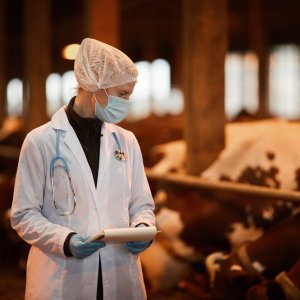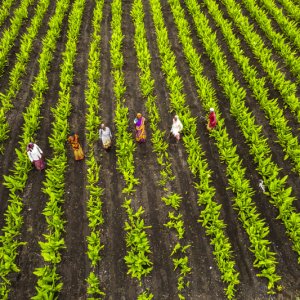
Untapped Potential In Mexico’s Food Industry
Anyone who believes the primary sector is not business material should visit Mexico. According to SAGARPA, in 2016, Mexico’s agricultural production increased 11 percent in 52 key crops compared to 2012, driven by growth of crucial export crops, such as apples, asparagus, blackberries, broccoli, avocados and green chilis. Between January and June 2017, Mexico registered total agricultural production of 113.7 million tons, a 1.8 percent variation from the same period during 2016. Rodrigo Domenzain, President of Amar Hidroponia, says success in the industry depends on the how a company goes about its business. “The primary sector is the base of the economy and offers significant business opportunities. It is about addressing the sector with the appropriate model.”
In addition to agriculture, the livestock segment is also thriving, reaching 6.5 million tons in 2016, 202,000 tons above 2015’s figures. 2017 appears poised to surpass the previous year’s milestone. During 2017’s first six months, carcass meat production increased 2.8 percent over the same period in 2016. National fish production has also enjoyed positive results, with 1.5 million tons caught in 2016. Between January and June 2017, national production registered growth totaling 23.2 percent, up from 853.5 thousand tons in 2016 to 1.05 million tons in 2017. The end result is that Mexico is now the 12th-largest food producer in the world.
While the GDP of the primary sector has displayed a healthy rise, from MX$405.3 billion to MX$448.9 billion between 2012 and 2016, according to SAGARPA data, and registered a 4.1 percent increase just in 2016 from the year before, the sector has suffered a reduced role in overall national GDP. INEGI figures show the primary sector’s contribution to the country’s GDP fell from 3.6 percent in 1993 to 3.1 percent in 2016. Still, the decline is in line with the global trend. World Bank data represent a decline in the contribution of agriculture to the global GDP from 5.2 percent in 2000 to 3.7 percent in 2015. Reasons for the decline vary, but BBVA Research credits the lack of dynamism in the sector when compared to manufacturing or services.
When distilling the sector down by food segment, it is a somewhat different tale that suggests that opportunities that exist. According to INEGI, during 2017’s first six months, the GDP for the food, beverages and tobacco industry totaled MX$1.28 billion, a 2.08 percent increase over the same period in 2016. In 2016 alone, the food, beverages and tobacco industry contributed 4.3 percent to the country’s GDP.
Mexico’s competitiveness in the food manufacturing sector is a factor in attracting investment to the country. The Ministry of Economy says that between 1999 and the first quarter of 2017, US$59.7 billion was directed to the agri-food sector, meaning food production, beverages and tobacco, with investments coming from the Netherlands, the US, Switzerland, Japan, Luxemburg and Spain. According to KPMG’s 2016 Competitive Alternatives, Mexico ranks as the most competitive country for food processing.
As of 2014, ProMéxico estimates that a total of 185,013 agri-food economic units – companies, plants, sales and commercial offices – were operating in the country, which has become an important base for international companies such as Dr. Pepper Snapple Group. “Grupo Peñafiel has four plants in Mexico. We are Dr. Pepper Snapple Group’s second-largest affiliate after the US,” says Gilberto Maldonado, Director General of Grupo Peñafiel.
US INFLUENCE
The country’s attractiveness in the food industry is boosted not only by its proximity to the US, but also because of its broad network of free trade agreements, commodities that are available all year-round, a qualified labor force and technology. Ulises Vergara, Vice President and General Manager of Conagra Brands in Mexico, says that the company’s Mexico production site ranks among the top of its 27 facilities around the world. “Due to the sustainability and efficiency programs we have implemented, our Mexican production facility ranks among the company’s best plants,” he says.
Competitiveness reflects on exports numbers. In 2016 alone, agricultural and agri-industrial exports reached US$28.9 billion. Between January and August 2017, exports registered US$2.6 billion more than in the same period in 2016.
Mexico’s closeness with the US, as well as logistics, make its northern neighbor the main recipient of exports. Data from the Foreign Agricultural Service of the US Department of Agriculture (USDA) show that in 2016, Mexican exports to the US totaled US$22.9 billion. SAGARPA says that the EU buys Mexican agri-food products totaling US$831 million.
While NAFTA renegotiations have flustered the markets, the Mexican agribusiness industry remains confident regarding the future of the agri-food relationship between Mexico and the US. Amar Hidroponia’s Domenzain says severing the existent interdependence through taxes makes no sense. “Almost 75 percent of the vegetables consumed in the US come from Mexico. If the US wanted to substitute all Mexican imports it would have to spend billions of dollars on high-tech greenhouses.”
NEW HORIZONS
One positive outcome of the NAFTA squabble is that it has spurred Mexico to broaden its own horizons in an attempt to reduce dependence with its northern neighbor and at the same time, gain leverage in the renegotiations. “If NAFTA disappears, I can export cars paying 2.5 percent tariffs. If they want to export yellow corn to me, I can raise tariffs to inaccessible levels. But to make that strategy credible, I have to broaden our agreements with Brazil and Argentina,” said Ildefonso Guajardo, Minister of Economy at Mexico Business Forum 2017.
Widening the breadth of its markets involves more than just signing commercial agreements, as Mexican production must comply with a series of certifications that allow access to other countries. According to the Presidential Office, Mexico is one of the five countries in the world to have all sanitary approvals, granting Mexican products access to 160 countries. This is no doubt an advantage for diversification. “With the implementation of the new sanitary protocols, we are now exporting berries and avocados to China and we are close to concluding the sanitary protocol for bananas,” says Liz Quintero, Director General of México Calidad Suprema.
Finding new markets, is only part of the equation in Mexico’s quest to strengthen its agri-business industry. Production modernization and participation in new consumption trends could contribute heavily to the industry. However, tradition and entrenchment, have made agriculture one of the sectors most resistant to change and modernization.
MODERNIZATION HURDLE
Yet, it is not an impossible task. Íñigo Pérez-Rasilla, Director General of SOFAGRO, believes it is a matter of providing the right incentives for change. “Farmers need to have incentives to change, otherwise they will continue doing things in the same way their grandparents did.” It is precisely within the modernization conundrum where export opportunities can be found. “It is more plausible for farmers to transform their production methods if their buyers and large exporters demand they modernize production to comply with international standards,” says Pérez-Rasilla.
Technology has also paved the way for new production methods that go beyond automation of agricultural processes. The use of technology to ensure sustainability and crop protection is increasingly becoming more common due to the economic benefits it entails. According to Javier Valdés, Director General of Syngenta Mexico, the use of technology can help farmers increase their productivity. “An unprotected crop can lose up to 40 percent of its productivity.” Nevertheless, the use of technology also generates a series of dilemmas, such as the use of genetically modified organisms (GMOs), an industry that according to the International Service for the Acquisition of Agri-Biotech Applications (ISAAA) in 2016 reached a US$15.8 billion value. In Mexico, the use of GMOs is the subject of discussion and weariness. However, Valdés sees it as a means to boost agricultural potential. “Biotechnology is just one more tool that producers can take advantage of. It is intended to simplify their life and help them produce more per hectare.”
Other new production trends such as the growing of organic crops could represent a source of untapped potential for the Mexican industry. According to SAGARPA, between 2012 and 2016 the area destined for the growth of organic crops doubled, reaching 1 million hectares and generating exports accounting for US$1.8 billion. SAGARPA’s next challenges are to position Mexico as the seventh-largest producer of organic food in the world and to make these products accessible, not only for international consumption but for domestic population as well.
















